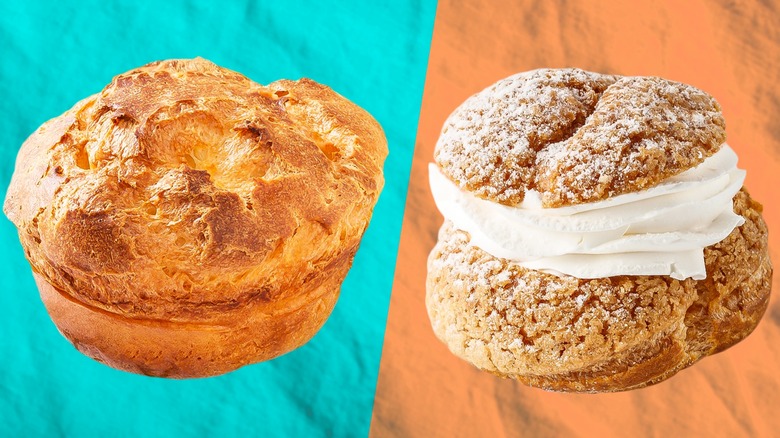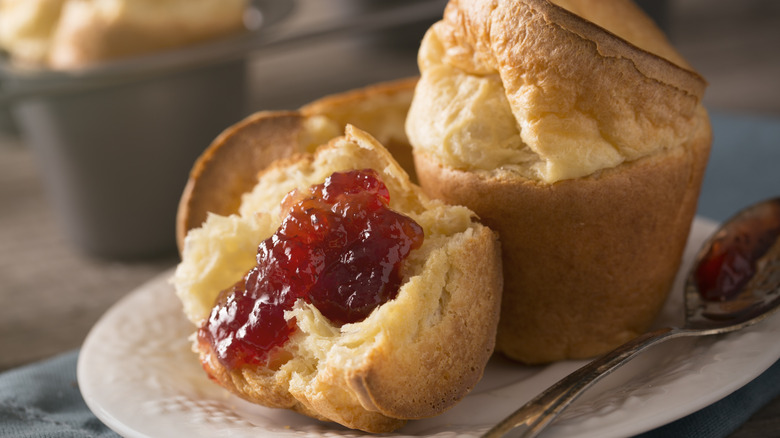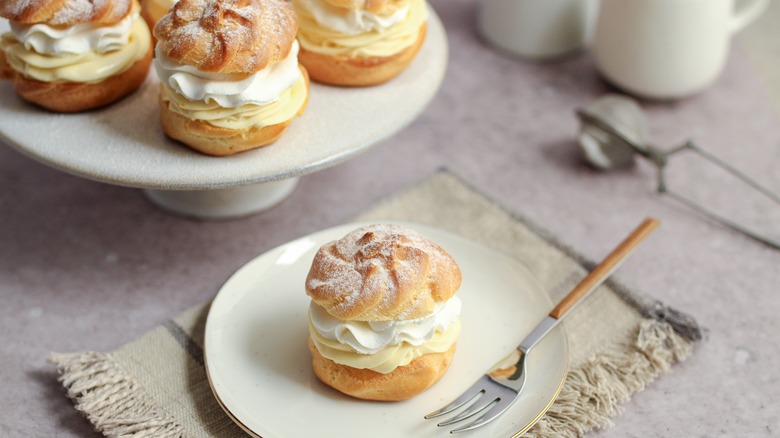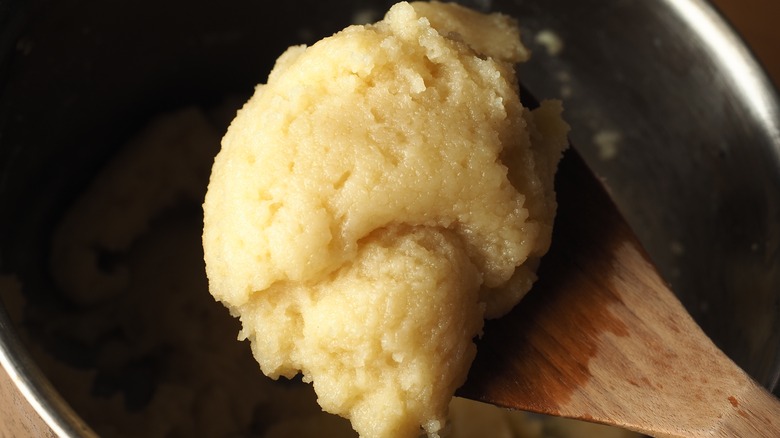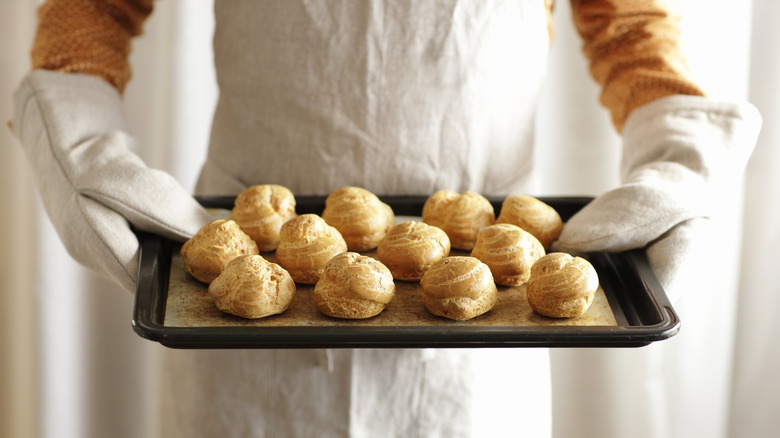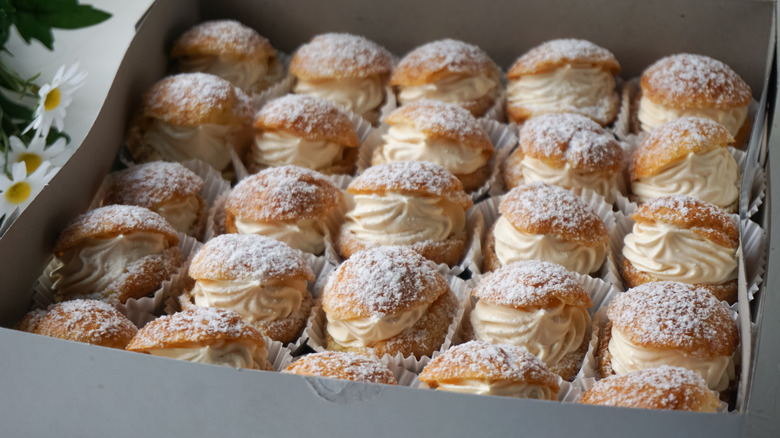Popovers Vs Cream Puffs: Is There A Difference?
Freshly baked goods are one of life's simple pleasures. A pastry so delicate and airy that you hardly meet any resistance as you sink your teeth into it is akin to taking the express elevator straight to heaven's pearly gates. Among these divine delicacies are two of our favorite lighter-than-air flour-based treats, popovers and cream puffs. Popovers and cream puffs are both pastries with soft, crispy exteriors and hollow centers; however, they're distinctly different items due to their recipe ratios and cooking methods. Popovers lean more savory (although they can be served alongside anything from rich, meaty dishes to butter and sweet jam), while cream puffs are slightly sweet, even before being filled with sweet cream.
Both popovers and cream puffs have similar base recipes, relying on not much more than eggs, milk, flour, and butter. Neither use any leaveners to create the rise in the batter — rather, the magic behind the light, fluffy dough is simply steam and a very hot oven. Popovers are savory and baked in specialty tins similar to muffin pans; they're usually served unadorned and unfilled. Cream puffs, on the other hand, are baked on a baking sheet and are usually sweet, as they're filled with a sweetened whipped cream mixture, sometimes with varying flavors.
What are popovers?
Dating back to at least the 1850s, popovers are an American version of the staple British food called Yorkshire pudding. The dish was updated when English settlers came to New England and slightly altered the recipe. While they are remarkably similar, there are some differences between popovers and Yorkshire pudding. Traditionally, Yorkshire pudding is cooked in leftover meat drippings, such as beef or duck fat, while American popovers tend to be cooked in butter or a nonstick cooking spray.
A popover doesn't contain any yeast, baking soda, or baking powder, yet it rises higher than most typical pastries due to rapidly forming steam looking for an escape. Popovers are identifiable by their signature towering height and golden color, and especially by their sky-high tops that look as if the batter bubbled up and practically exploded out of the baking tin.
As shown in our easy popover recipe, the batter comes together with minimal effort, and they bake in under 10 minutes. After that, a very simple extra step will ensure your popovers stay crisp before serving, as you want the pastries to be as light, hollow, and crisp as possible. There's nothing quite as tragic as a sad, soggy popover. Popovers are generally eaten as an accompaniment to salads, soups, or roast meats, as they're lighter than a roll or slice of bread. Alternatively, they make a great breakfast item when served with fruit jam and salted butter.
What are cream puffs?
The history of the cream puff is shrouded in myth and mystery, but the origins are undoubtably French. Cream puffs, also known as profiteroles, have been around since the 16th century, when a French chef accidentally added excess flour to a dough but baked it anyway — and the results were delicious.
Cream puff are made from pâte à choux, also known simply as choux, which is an egg-based dough. This dough is cooked in a pot before being piped out onto baking sheets and placed in a hot oven. Pâte à choux is a blank canvas for many items you'd encounter in a pâtisserie, and it can be savory or sweet, depending on the filling or flavorings added to the dough. Classic gougères, for example, are the same shape as cream puffs but have shredded cheese folded into the batter, while eclairs are an oblong shape stuffed with pastry cream and topped with a chocolate glaze.
Cream puffs can take on many flavor profiles (just check out our recipes for chocolate cream puffs and vanilla cream puffs), and once you've mastered the basics, you can even try flashier presentations, like these gourmet cream puff swans. Cream puffs can be left unadorned, dusted with powdered sugar, or topped with a chocolate glaze.
Popover batter and choux dough are vastly different
Pâte à choux is made with more eggs than popover batter, which lends more stability to the dough so it can hold its shape. Cream puffs get their richness from the extra eggs in both the batter and the creamy filling, whereas popovers' rich, buttery taste and mouthfeel come more from the fat used to coat the pan in the cooking process.
Cream puff dough should be made and used fresh, while popover batter is combined in a blender or whisked together and usually needs to rest for anywhere from 15 minutes to overnight in the refrigerator, allowing the flour to properly hydrate. Unlike traditional cream puffs, it's easy and common to add flavorings into popovers as long as they don't weigh down the batter, like minced fresh herbs or a bit of finely shredded cheese, like these Gruyère and black pepper popovers.
Making pâte à choux is much more labor-intensive than whipping up a popover batter, as it involves incorporating the butter, milk, and flour vigorously by hand on the stove, then waiting for the batter to cool before adding the eggs. These are incorporated one by one into the slightly cooled batter, which is then transferred to a piping bag and piped in identical mounds onto a baking sheet before sliding into a hot oven to fully bake. Some cream puffs include craquelin on top before baking, giving them a crunchy topping that makes them even tastier.
Both pastries are oven-baked, but in very different manners
In general, popovers tend to be much larger than cream puffs, which range in size from golf balls to small lemons, depending on the recipe. While a traditional muffin tin will work for popovers, they generally call for a specialized pan that has narrower, higher, and straighter sides than a muffin tin. Popover pans transfer heat more directly and quickly to the very wet, loose batter, as opposed to muffin tins, which are meant for a much thicker batter. Popover batter is poured into a hot pan, which has been preheating in the oven and already coated with fat.
Once the batter is poured, the pan returns to the hot oven, and the oven temperature is reduced about halfway through baking. One of the most important things to know about baking popovers is that under no circumstances should the oven door be opened during the cooking process, as you don't want to let in any cooler air, which would decrease the popovers' towering rise.
In contrast, cream puffs are piped directly onto a baking sheet in neat rows, usually with about 1 tablespoon's worth of batter. This small mound of dough will puff up in the oven as steam is released, creating a round ball with a completely hollowed-out center.
Serving and storing popovers and cream puffs
Popovers should be served and eaten immediately after baking, as this is when they're at their peak flavor and texture. In the unlikely event that there are a few leftover, popovers can be store in an airtight container either at room temperature or in the refrigerator for one day. Any longer than that, and they'll significantly lose their luster. Day-old popovers should be reheated in an oven before eating.
Unlike popovers and their fleetingly short shelf life, cream puffs can handle the wait. In fact, the baked puffs need to cool off completely before they're filled, ensuring that the delicate dairy filling doesn't melt when it comes into contact with the hollow pastries. Smaller cream puffs can be pierced with a narrow piping tip and filled from the bottom, while larger cream puffs tend to have their tops sliced off before filling; the tops are then returned to the filled puffs like little hats.
Filled cream puffs are at their best when eaten the same day. Any leftover cream puffs will usually last for about two days in the refrigerator before becoming too soggy to properly enjoy. They should be stored in an airtight container so the refrigerator's humidity doesn't saturate the dough. Whichever pastry you choose, you can appreciate the differences between — and the methods behind — either form of deliciousness.
